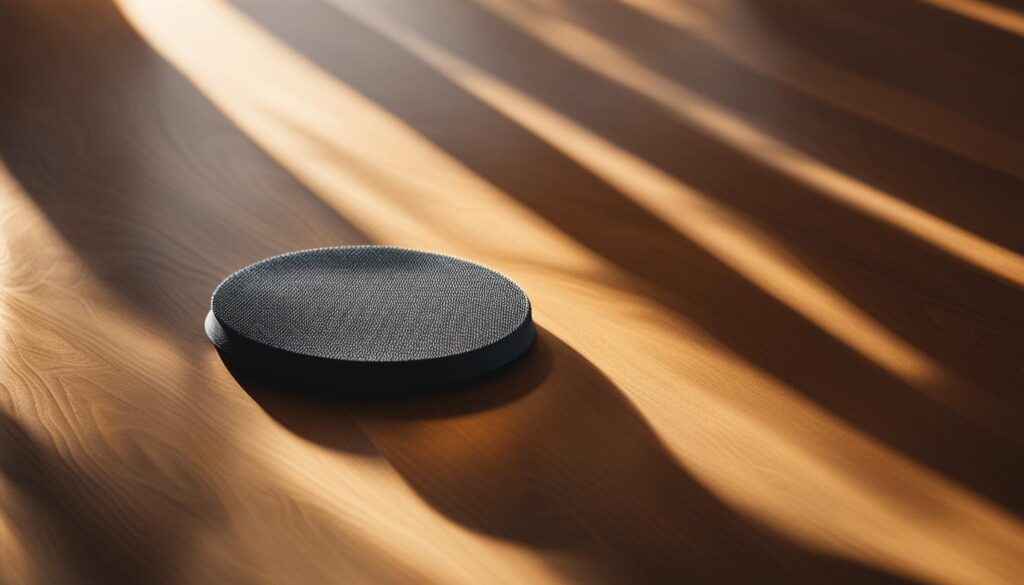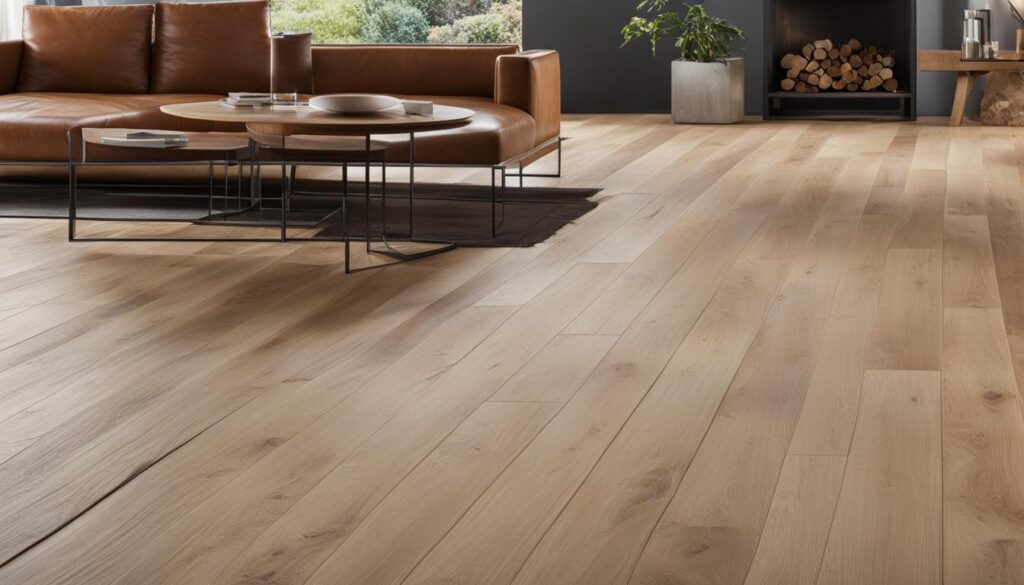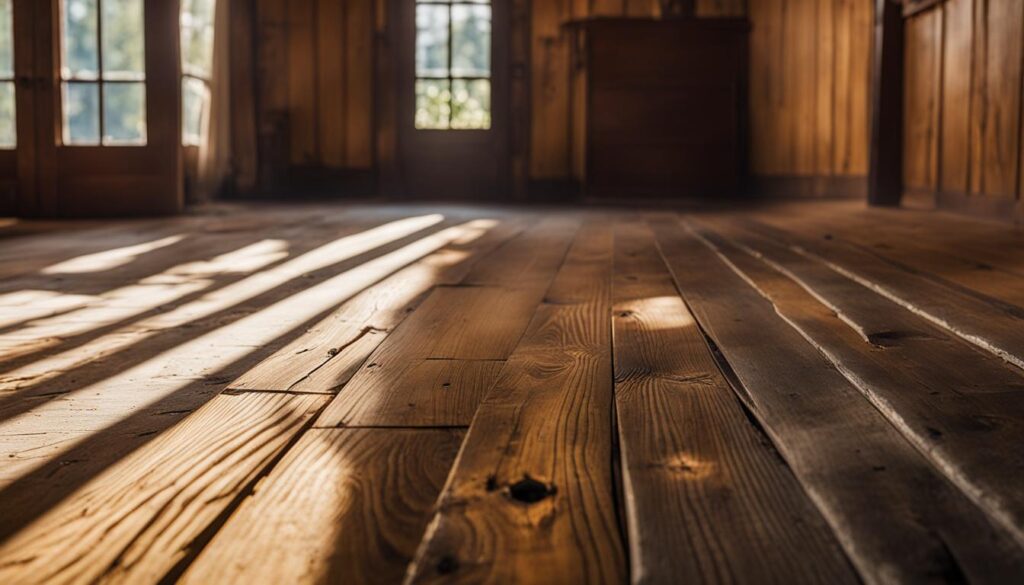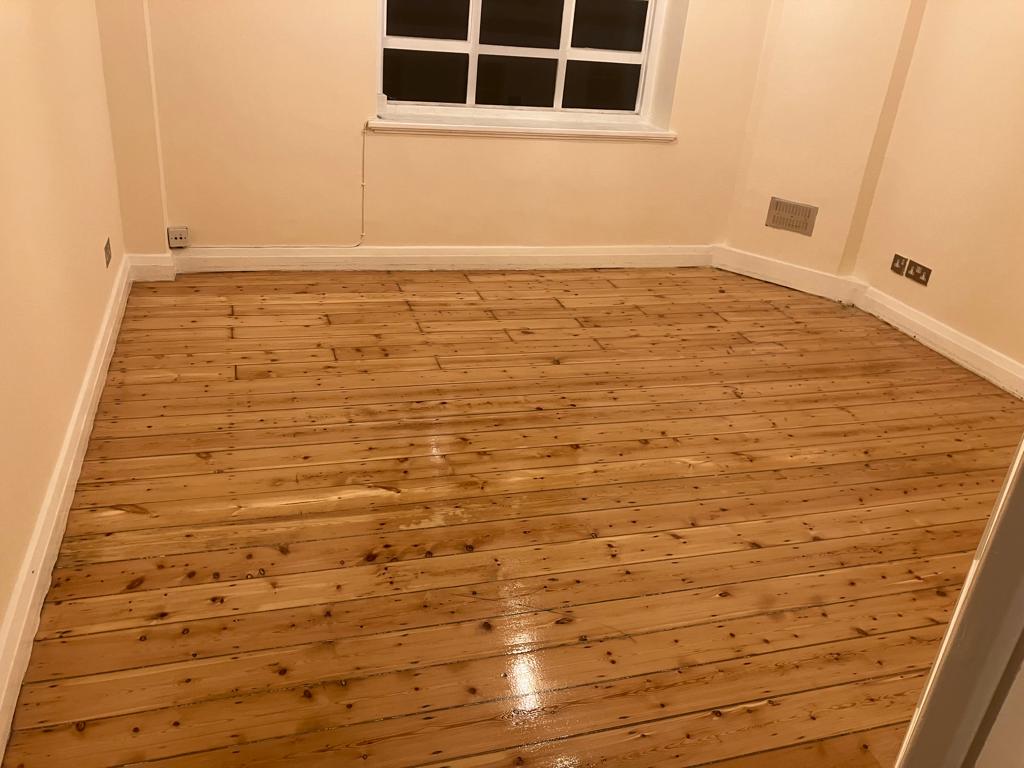If you’re considering revamping your hardwood floors, why not go green? Wooden floor restoration doesn’t have to harm the environment. With eco-friendly techniques and materials, you can breathe new life into your floors while maintaining sustainability.
In this section, we’ll explore how the incorporation of sustainable practices can enhance the process of wooden floor restoration. From sanding to refinishing and repairs, we’ll discuss how conscious decisions throughout the restoration process can promote environmental wellness.
Key Takeaways
- Eco-friendly restoration techniques can maintain the beauty of your floors without harming the environment.
- The restoration process includes sanding, refinishing, and repairs.
- Conscious decisions can promote environmental wellness throughout the restoration process.
- Sustainability doesn’t have to sacrifice aesthetics.
- By incorporating sustainable practices, you can create a beautiful and sustainable sanctuary in your home or business.
Understanding the Process: Floor Sanding and Refinishing
Wooden floors add beauty and value to any property. However, over time, they can lose their shine and become damaged. That is where floor sanding, refinishing, and repair come in. These are essential steps that can breathe new life into your floors.
First, floor sanding is necessary to remove the old finish, scratches, and stains from the surface of the wooden floor. This step prepares the wood for refinishing, allowing for a fresh new look. After sanding, any wood floor repairs needed, such as fixing loose boards, cracks, or chips, should be made.
Next, floor refinishing is the process of applying a new finish to the wooden floor. This step involves adding a protective layer that enhances the natural beauty of the wood while preventing wear and tear. There are various types of finish available, including water-based, oil-based, and wax. Each of these provides different benefits, so it is important to ask an expert for advice on which will work best for your specific situation.
Throughout this process, it is essential to work with a trustworthy and experienced professional, who can ensure that the job is done efficiently and correctly. In the end, the result will be a smooth, durable, and aesthetically pleasing wooden floor that can add value to your property for years to come.

Floor Recoating
If your wooden floor has started to show signs of wear, such as scratches or fading color, it may be time to consider floor recoating. This process involves adding a fresh coat of finish to your floors to protect them from further damage. Recoating can help to prolong the life of your wooden floor and keep it looking newer for longer.
“Regular maintenance is essential to keep your floors looking their best and to prevent wear and tear that can lead to costly repairs.”
By following these essential maintenance practices, you can keep your wooden floor looking beautiful and vibrant for years to come. Remember that prevention is key, and regular maintenance is much more cost-effective than repairs or replacement in the long run.
Embracing Sustainability: Eco-Friendly Floor Resurfacing
As awareness grows regarding environmental concerns, eco-friendly floor resurfacing options are becoming increasingly popular. Wooden floor restoration and resurfacing can now be completed sustainably and efficiently.
| Benefits of Eco-Friendly Floor Resurfacing |
|---|
| 1. Reducing environmental impact: By using eco-friendly materials and methods, the impact on the environment is minimized. |
| 2. Improved air quality: Traditional floor resurfacing products contain volatile organic compounds (VOCs), which are harmful to human health and the environment. Eco-friendly products, however, do not emit any toxic chemicals, thus improving air quality. |
| 3. Sustainability: By choosing eco-friendly options, we contribute to the planet’s sustainability. Eco-friendly materials are often renewable, reducing the need for wastage. |
Nowadays, there are many sustainable floor resurfacing options available on the market, including recycled wood, bamboo, and cork. Additionally, eco-friendly finishes are becoming more popular, such as natural oils and water-based finishes.
“Sustainable floor resurfacing is essential to create a safer and healthier environment for ourselves and future generations.”
By embracing eco-friendly approaches to floor resurfacing, you can make a positive impact on the environment and enjoy a beautiful, renewed wooden floor at the same time.

Conclusion
In conclusion, sustainable wooden floor restoration provides a perfect fusion of aesthetics and eco-consciousness. By incorporating eco-friendly techniques into the process of floor sanding, refinishing, maintenance, and resurfacing, you can create a beautiful and sustainable sanctuary in your home or business.
Wooden floors are a charming addition to any space, and they deserve to be restored using eco-friendly methods. Sustainable practices not only help conserve the environment but also guarantee long-term durability and low maintenance costs.
We urge you to embrace the beauty of nature while preserving it for future generations. Let’s take the step towards creating a healthier and more sustainable world by opting for eco-friendly wooden floor restoration.
FAQ
What is wooden floor restoration?
Wooden floor restoration is the process of repairing and refinishing worn-out or damaged wooden floors to restore their beauty, durability, and functionality.
Why should I consider wooden floor restoration?
Wooden floor restoration can breathe new life into your floors without the need for costly replacements. It allows you to maintain the original charm and character of your hardwood floors while extending their lifespan.
How often should I restore my wooden floors?
The frequency of wooden floor restoration depends on factors such as the level of wear and tear, the type of finish, and the quality of the previous restoration. In general, it is recommended to restore your floors every 10-15 years or as needed.
What is involved in the process of floor sanding and refinishing?
Floor sanding and refinishing involve removing the old finish, sanding the wood to smooth out imperfections, and applying a new finish or stain. This process helps to restore the natural beauty of the wood and remove scratches, stains, and signs of wear.
Can wooden floor restoration fix damaged or uneven floors?
Yes, wooden floor restoration can effectively repair damaged or uneven floors. Skilled professionals can assess the condition of your floors and use techniques such as floor levelling or plank replacement to address any issues before refinishing.
How can I maintain the luster of my restored wooden floors?
Regular maintenance practices such as sweeping, vacuuming, and using a damp mop can help to remove dirt and debris that can dull the shine of your wooden floors. Periodic floor polishing and recoating can also restore the luster and protect the surface from wear.
Is wooden floor restoration an eco-friendly option?
Yes, wooden floor restoration is an eco-friendly option. By restoring your existing floors, you prevent the need for new materials and reduce waste. Additionally, many professionals offer eco-friendly finishes and techniques that minimize the impact on the environment.
How long does the floor restoration process typically take?
The duration of the floor restoration process can vary depending on factors such as the size of the area, the extent of the damage, and the desired finish. It is best to consult with a professional who can provide you with an accurate estimate based on your specific project.
Can I walk on my floors immediately after restoration?
The time it takes for the newly restored floors to dry and cure can vary depending on the type of finish used. It is recommended to wait for the specified drying time provided by the professionals before walking on the floors or moving furniture back into the room.
How much does wooden floor restoration cost?
The cost of wooden floor restoration depends on factors such as the size of the area, the extent of the damage, the type of wood, and the desired finish. It is best to request a quote from a reputable restoration professional who can provide an accurate estimate based on your specific needs.





